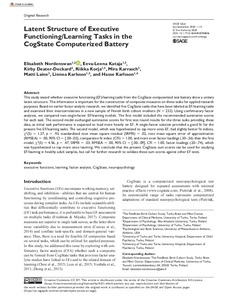The Development of the Iron-Based Batteries : From Baghdad Battery to Modern Solutions
Sirama, Sara (2025-04-17)
The Development of the Iron-Based Batteries : From Baghdad Battery to Modern Solutions
Sirama, Sara
(17.04.2025)
Julkaisu on tekijänoikeussäännösten alainen. Teosta voi lukea ja tulostaa henkilökohtaista käyttöä varten. Käyttö kaupallisiin tarkoituksiin on kielletty.
suljettu
Julkaisun pysyvä osoite on:
https://urn.fi/URN:NBN:fi-fe2025042530880
https://urn.fi/URN:NBN:fi-fe2025042530880
Tiivistelmä
There is a growing need for large-scale, efficient, and sustainable battery technologies to support the transition to renewable energy sources. This thesis explores the development of iron-based batteries, highlighting iron's abundance, cost-effectiveness, and environmental benefits as a competitive alternative to other material-based batteries.
Iron-based batteries offer a stable, affordable, and scalable solution for energy storage. Compared to conventional lithium-ion and lead-acid batteries, they present advantages in durability, material availability, and safety. Nickel-iron, iron-air, iron-sulfur, and iron-based redox flow batteries are examined to evaluate their electrochemical performance, efficiency, and application potential. The thesis examines the relationship between these battery types, identifying key innovations and historical developments that have shaped their development.
The findings indicate that while iron-based batteries demonstrate excellent longevity and cost benefits, they face challenges in energy density, charge-discharge rates, and efficiency due to side reactions such as hydrogen evolution. However, recent advances in electrode materials, electrolyte formulations, and nanotechnology demonstrate promising improvements in addressing these issues. Expanding uses in renewable energy storage, large-scale grid integration, and industrial power backup highlight their reliability as a long-term energy storage solution.
Future research should focus on improving energy density, optimizing charge-discharge efficiency, and addressing scalability issues. With continued innovation, iron-based batteries could be crucial in advancing sustainable energy storage, reducing dependence on critical raw materials, and supporting the transition to cleaner and more reliable energy systems. Laajamittaisille, tehokkaille ja kestävän kehityksen mukaisille akkuteknologioille on kasvava tarve tukemaan siirtymistä uusiutuviin energialähteisiin. Tämä tutkielma tarkastelee rautapohjaisten akkujen kehitystä ja korostaa raudan runsautta, kustannustehokkuutta ja ympäristöhyötyjä kilpailukykyisenä vaihtoehtona muihin materiaalipohjaisiin akkuihin. Rautapohjaiset akut tarjoavat vakaan, edullisen ja skaalautuvan ratkaisun energian varastointiin. Perinteisiin litiumioni- ja lyijyakkuihin verrattuna ne tarjoavat etuja kestävyyden, materiaalien saatavuuden ja turvallisuuden suhteen. Nikkeli-rauta-, rauta-ilma-, rauta-rikki- ja rautapohjaisia redoxvirtausakkuja tarkastellaan niiden sähkökemiallisen suorituskyvyn, tehokkuuden ja sovellusmahdollisuuksien arvioimiseksi. Tutkielma selvittää näiden akkutyyppien keskinäistä suhdetta ja tunnistaa keskeiset innovaatiot sekä historialliset kehitysvaiheet, jotka ovat muokanneet niiden kehitystä. Tulokset osoittavat, että vaikka rautapohjaiset akut osoittavat erinomaista pitkäikäisyyttä ja kustannushyötyjä, ne kohtaavat haasteita energiatiheyden, lataus-purkausnopeuden ja tehokkuuden osalta sivureaktioiden, kuten vedyn kehittymisen vuoksi. Viimeaikaiset edistysaskeleet elektrodimateriaaleissa, elektrolyyttikoostumuksissa ja nanoteknologiassa osoittavat kuitenkin lupaavia parannuksia näiden ongelmien ratkaisemisessa. Laajeneva käyttö uusiutuvan energian varastoinnissa, laajamittaisessa sähköverkon integraatiossa ja teollisuuden varavoimaratkaisuissa korostaa niiden luotettavuutta pitkäaikaisena energian varastointiratkaisuna. Tulevan tutkimuksen tulisi keskittyä energiatiheyden parantamiseen, lataus-purkaustehokkuuden optimointiin ja skaalautuvuuteen liittyvien ongelmien ratkaisemiseen. Jatkuvan innovoinnin myötä rautapohjaiset akut voivat olla keskeisessä roolissa kestävän energian varastoinnin edistämisessä, kriittisistä raaka-aineista riippuvuuden vähentämisessä ja siirtymässä kohti puhtaampia ja luotettavampia energiajärjestelmiä.
Iron-based batteries offer a stable, affordable, and scalable solution for energy storage. Compared to conventional lithium-ion and lead-acid batteries, they present advantages in durability, material availability, and safety. Nickel-iron, iron-air, iron-sulfur, and iron-based redox flow batteries are examined to evaluate their electrochemical performance, efficiency, and application potential. The thesis examines the relationship between these battery types, identifying key innovations and historical developments that have shaped their development.
The findings indicate that while iron-based batteries demonstrate excellent longevity and cost benefits, they face challenges in energy density, charge-discharge rates, and efficiency due to side reactions such as hydrogen evolution. However, recent advances in electrode materials, electrolyte formulations, and nanotechnology demonstrate promising improvements in addressing these issues. Expanding uses in renewable energy storage, large-scale grid integration, and industrial power backup highlight their reliability as a long-term energy storage solution.
Future research should focus on improving energy density, optimizing charge-discharge efficiency, and addressing scalability issues. With continued innovation, iron-based batteries could be crucial in advancing sustainable energy storage, reducing dependence on critical raw materials, and supporting the transition to cleaner and more reliable energy systems.
Kokoelmat
Samankaltainen aineisto
Näytetään aineisto, joilla on samankaltaisia nimekkeitä, tekijöitä tai asiasanoja.
-
Electrospun nanofiber membrane in lithium-ion batteries and supercapacitors : Current markets and future growth potential
Sarkki, Sami (Turun yliopisto, 10.07.2018)With the world dynamically changing and countries drastically cutting their CO2 emissions, the need for fossil fuel replacement is necessary. Electric vehicles are seen as the alternative means of transport and the future ... -
Association between structural brain connectivity and The Cambridge Neuropsychological Test Automated Battery (CANTAB) following mild traumatic brain injury
Marino, Giorgia (20.05.2020)The purpose of this study was to investigate the association of global brain network properties with two different CANTAB domains on average eight months at their chronic stage, after mTBI. After mTBI, patients deal with ...avoin -
Latent Structure of Executive Functioning/Learning Tasks in the CogState Computerized Battery
Hasse Karlsson; Kirby Deater-Deckard; Mira Karrasch; Matti Laine; Eeva-Leena Kataja; Riikka Korja; Elisabeth Nordenswan; Linnea KarlssonThis study tested whether executive functioning (EF)/learning tasks from the CogState computerized test battery show a unitary latent structure. This information is important for the construction of composite measures on ...

